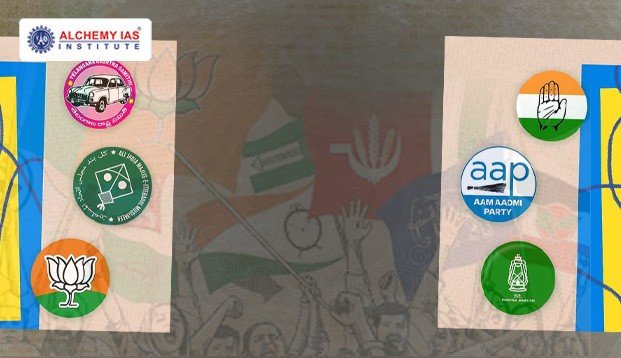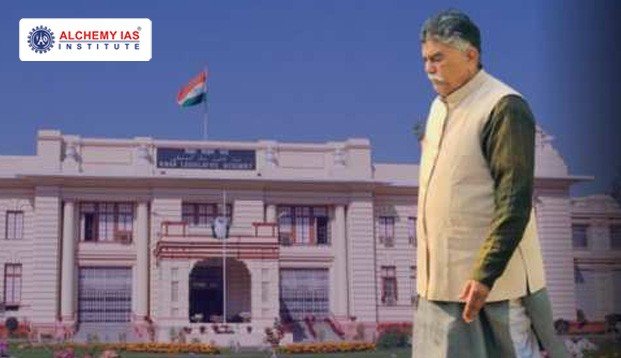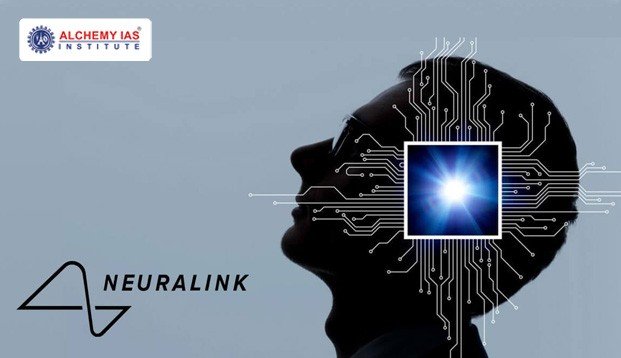The news analysis is prepared based on The Hindu‘s Delhi edition.
8th February, 2024 (Thursday)
| CONTENT LIST | ||
| Topics | Syllabus | |
| 1 | Allocation of Election Symbols | GS.2: Indian Polity – Electoral System in India |
| 2 | Lokpal | GS.2: Indian Polity – Important Bodies in News |
| 3 | Removal of Speaker | GS.2: Indian Polity – State Legislature |
| 4 | GPS-based toll collection system | GS.3: Science & Technology |
| 5 | Fiscal Deficit | GS.3: Indian Economy: Public Finance |
| 6 | Artificial Neural Network | GS.3: Science & Technology |
| 7 | Production Gap Report, 2023 | GS.3: Environmental Pollution & Degradation |
ALLOCATION OF ELECTION SYMBOLS
Syllabus: GS.2: Indian Polity – Electoral System in India

Why it’s in the News: The Election Commission has approved a new name — the ‘Nationalist Congress Party-Sharadchandra Pawar’ — for NCP chief Sharad Pawar’s faction a day after it awarded the party’s original name and clock symbol to the rival NCP faction headed by Mr. Pawar’s nephew and Maharashtra Deputy CM Ajit Pawar.
About Allotment of Election Symbols in India
- Who Allocates Symbols to Political Parties?
- The Election Commission of India (ECI) allocates symbols to political parties under The Election Symbols (Reservation and Allotment) Order, 1968. This order governs the specification, reservation, choice, and allotment of symbols for parliamentary and assembly elections, recognizing political parties.
- Types of Symbols: Reserved and Free
- Symbols can be reserved for recognized political parties or remain free for unrecognised registered parties’ candidates.
- Recognized national and state parties receive exclusive symbols, chosen by the party leadership.
- Unrecognized parties can choose from a list of free, non-exclusive symbols.
- Selection Process and Notification
- Parties select symbols, which are then published by the EC in the Gazette of India.
- As of recent notifications, there are six national parties, 26 state parties, and 2,597 registered unrecognised parties.
- Origins of Symbols
- Symbols like clock, lotus, and hen originated from brainstorming sessions led by the late MS Sethi and ECI officials. These sessions aimed to identify objects familiar to the common man, resulting in a diverse range of symbols.
- Preference Submission by Parties
- Unregistered parties must submit preferences for symbols from a list provided by the EC.
- They can also propose new symbols, subject to EC approval, ensuring no resemblance to existing symbols or religious connotations.
- Handling Party Splits
- In cases of party splits, the EC decides on symbol allocation.
- Historical examples include the evolution of the Congress party’s symbol from a pair of bulls to the current hand symbol.
- Recent Instances
- The EC resolved symbol disputes within the Shiv Sena, assigning different symbols to rival factions. Requests for symbols with religious connotations were rejected, ensuring neutrality in symbol allocation.
| NEWS PLUS Registration of Political Parties: According to the Election Commission, any party seeking registration must apply to the Commission within 30 days following its formation, following guidelines prescribed by the Commission. This authority stems from Article 324 of the Constitution of India and Section 29A of the Representation of the People Act, 1951. The registration of all political parties is regulated by the provisions of Section 29A of the Representation of the People Act, 1951. |
LOKPAL
Syllabus: GS.2: Indian Polity – Important Bodies in News
Why it’s in the News: Former Supreme Court judge A.M. Khanwilkar is likely to be appointed the next Lokpal of India

About Lokpal
- Established four years ago, the Lokpal of India serves as the country’s premier anti-corruption body, tasked with investigating complaints against public functionaries.
- Despite the Lokpal and Lokayukta Act passing in 2013, the first Lokpal, along with eight members, was appointed on March 19, 2019.
- Background:
- Derived from Sanskrit, “Lokpal” signifies “protector of the people.”
- The concept of an ombudsman originated in Scandinavian nations, particularly Sweden in 1713, evolving significantly in the 20th century.
- The term Lokpal and Lokayukta were coined by Dr. L. M. Singhvi.
- The Lokpal and Lokayukta Act, 2013, mandate the establishment of Lokpal for the Union and Lokayukta for states.
- These institutions are statutory bodies without any constitutional status.
- Key Provisions of the Lokpal and Lokayukta Act, 2013:
- The Act specifies that at least 50% of Lokpal members should belong to marginalized communities. It sets salary and service conditions equivalent to those of senior judicial positions. These bodies hold statutory authority but lack constitutional status.
Structure of Lokpal:
- Composition:
- Lokpal is a multi-member body comprising a chairperson and a maximum of 8 members.
- Out of these members, half are judicial members.
- Chairperson Criteria:
- The chairperson must be either a former Chief Justice of India, a former Judge of the Supreme Court, or an eminent individual with impeccable integrity and exceptional expertise.
- They should possess a minimum of 25 years of experience in areas related to anti-corruption policy, public administration, vigilance, finance (including insurance and banking), law, and management.
- Member Composition:
- At least 50% of Lokpal members are from marginalized communities such as SC/ST/OBC/Minorities and women.
- Judicial members are typically former Supreme Court Judges or former Chief Justices of High Courts.
- Term of Office:
- The term for the Lokpal chairperson and members is 5 years or until they reach the age of 70.
- Appointment Process:
- Members are appointed by the President based on the recommendation of a Selection Committee.
- The Selection Committee is chaired by the Prime Minister and includes the Speaker of Lok Sabha, the Leader of Opposition in Lok Sabha, the Chief Justice of India (or a nominated Judge), and one eminent jurist.
- Selection Procedure:
- The Selection Committee establishes a search panel comprising a minimum of eight individuals to aid in the selection of the chairperson and members.
- The Amendment Bill of 2016:
- This bill revises the declaration of assets and liabilities by public servants, requiring disclosure within 30 days of office entry.
- Rationale for Lokpal:
- Existing agencies lack independence, often reporting to accused individuals.
- Institutions like the CVC lack enforcement powers and face transparency issues, leading to ineffective anti-corruption measures.
- Challenges Ahead:
- The Lokpal’s appointing committee is susceptible to political influence.
- Lack of defined criteria for appointing members poses challenges, along with inadequate protection for whistleblowers and exclusion of the judiciary from Lokpal oversight.
Way forward
- As India leads the G20 Anti-Corruption Working Group, the Lokpal must enhance the nation’s anti-corruption framework.
- Strengthening accountability mechanisms and addressing existing loopholes are imperative for effective governance.
REMOVAL OF SPEAKER
Syllabus: GS.2: Indian Polity – State Legislature
Why it’s in the News: Bihar Assembly Speaker Awadh Bihari Choudhary’s recent announcement regarding his intent to remain in office until the Assembly session on February 12, coinciding with JD(U) leader Nitish Kumar’s impending floor test, has sparked discussion.

About Removal of Speaker in State Legislature
- In Indian Polity, Articles 178 to 187 pertains to the officers of the state legislature, encompassing roles such as Speaker, Deputy Speaker, Chairman of LC, and Deputy Chairman of LC.
- Process of Vacation, Resignation, and Removal:
- Vacation of Office: According to Article 179 of the Indian Constitution, a member holding office as Speaker or Deputy Speaker of an Assembly shall vacate their office if they cease to be a member of the Assembly.
- Resignation: They may resign at any time by submitting a written resignation to the Deputy Speaker (in the case of the Speaker) or to the Speaker (in the case of the Deputy Speaker).
- Removal:
- Removal from office requires a resolution passed by a majority of all the then members of the Assembly.
- This resolution cannot be moved without at least fourteen days’ notice.
- Additionally, the Speaker does not vacate office upon dissolution of the Assembly but holds the position until immediately before the first meeting of the Assembly after dissolution.
- This constitutional provision ensures a systematic process for the vacation, resignation, and removal of the Speaker and Deputy Speaker, maintaining stability and accountability within the legislative framework.
GPS-BASED TOLL COLLECTION SYSTEM TO REPLACE THE FASTAG
Syllabus: GS.2: Indian Polity: Judicial Review
Why it’s in the News: In December 2023, the National Highways Authority of India (NHAI) announced plans to revolutionize toll collection on highways. The aim was to replace traditional toll plazas with cutting-edge GPS-based systems by March 2024.

Government’s Commitment to Innovation
- Union Minister for Road Transport, Nitin Gadkari, reiterated the government’s commitment to implementing the new system nationwide by March the following year.
- Gadkari also emphasized the successful completion of two pilot projects involving Automatic Number Plate Recognition (ANPR) cameras.
- These projects aim to enable automated toll collection without vehicles needing to stop, ultimately reducing traffic congestion.
Understanding the GPS-Toll Collection System
- The GPS-based toll collection system operates seamlessly using either a GPS device installed in vehicles or ANPR cameras.
- These devices track vehicles’ movements, identifying entry and exit points on tolled sections and calculating charges based on the distance traveled.
- This approach replaces the outdated fixed tolls at booths, ensuring fairer charges for drivers based on the actual distance covered.
Convenience and Efficiency
- One of the key benefits of the new system is the convenience it offers to motorists.
- With the toll amount automatically deducted from linked accounts through a secure electronic payment system, drivers can traverse highways without interruptions.
- This not only enhances convenience but also minimizes the risk of human error and toll evasion.
By embracing innovative technologies, India’s highway infrastructure is poised for a significant transformation, promising smoother journeys and improved efficiency for all road users.
| NEW PLUS About FASTag FASTag, available in seven different colours, is valid for five years. Each colour corresponds to a specific vehicle category, simplifying identification and usage.Launched in April 2016, FASTag became mandatory for all new cars and trucks from December 1, 2017, before their sale.To promote FASTag adoption, NHAI refunds 5% of the total monthly transactions, encouraging drivers to opt for electronic toll payment.IHMCL and NPCI are spearheading the implementation of FASTag, a joint initiative by NHAI and the Indian government.Presently operational on both national and state highways, FASTag offers a seamless toll payment experience for motorists across India. |
FISCAL DEFICIT
Syllabus: GS.3: Indian Economy: Public Finance
Why it’s in the News: The fiscal deficit for 2024-25 is expected to go down to 5.1%, a decline of 0.7 percentage points from the previous year.
Understanding Fiscal Deficit
- Definition:
- The fiscal deficit signifies the variance between the government’s total expenditure and its total revenue, excluding borrowings. It serves as a crucial metric indicating the extent to which the government needs to borrow to sustain its operations, typically expressed as a percentage of the country’s GDP.
- Implications of High and Low Fiscal Deficit:
- High Fiscal Deficit: Can trigger inflation, currency devaluation, and escalate the national debt burden.
- Low Fiscal Deficit: Signifies fiscal discipline and a robust economy.
- Positive Aspects of Fiscal Deficit:
- Boosts Government Spending: Enables increased investment in public services, infrastructure, and other critical areas, fostering economic growth.
- Supports Public Investments: Facilitates funding for long-term projects like infrastructure development.
- Promotes Job Creation: Increased government spending can lead to employment opportunities, reducing unemployment rates and enhancing living standards.
- Negative Aspects of Fiscal Deficit:
- Mounting Debt Burden: Prolonged high fiscal deficit escalates government debt, burdening future generations with repayment obligations.
- Inflationary Pressure: Large fiscal deficits can trigger increased money supply and inflation, diminishing public purchasing power.
- Crowds Out Private Investment: Heavy government borrowing may hike interest rates, impeding private sector access to credit and hindering private investment.
- Balance of Payments Concerns: Excessive fiscal deficits may necessitate foreign borrowing, depleting foreign reserves and straining the balance of payments.
Artificial Neural Network
Syllabus: GS. 3: Science and Technology
Why it’s in the News: Artificial Neural Networks (ANNs) are making headlines again due to a breakthrough in drug discovery. Researchers have developed an explainable deep-learning method that identifies antibiotic properties and substructures, paving the way for faster drug development.

About Artificial Neural Networks (ANNs)
To understand ANNs better, let’s break down their setup and significance:
- Setting up of ANNs:
- Graphic Processing Units (GPUs) are preferred over CPUs for setting up ANNs due to their ability to handle massive parallel tasks efficiently.
- Free ANN frameworks like TensorFlow, Keras, PyTorch, and Theano facilitate both traditional machine learning tasks and advanced deep learning/ANN tasks.
- Why called Neural Network?
- The term originates from the brain’s neuron, inspiring computer scientists since the 1950s to replicate brain-like functionality in computers.
- The complexity of mimicking the brain’s functions underscores the challenge.
- Understanding Artificial Neural Networks:
- ANNs are machine learning models inspired by the human brain’s structure and function.
- Comprising interconnected nodes called artificial neurons, ANNs process and analyze information.These neurons, organized into layers, receive input, perform computations, and produce output. Weights associated with connections between neurons are adjusted during training via backpropagation.
- ANNs are versatile, with various types such as feedforward, recurrent, and convolutional networks, each suited to distinct applications.
- Popularity of ANNs:
- ANNs, integral to Data Science and Machine Learning, automate pattern detection tasks.
- Hand-written digit recognition exemplifies machine learning’s potential, though it necessitates extensive manual labeling of sample data.
- ANNs, employing backpropagation, automate this process, explaining their surging popularity over the past decade.
- Applications of ANNs:
- Image recognition, natural language processing, speech recognition, recommender systems, financial forecasting, gaming, medical diagnosis, robotics, control systems, and fraud detection are among the myriad applications.
- ANNs’ adaptability and learning capabilities promise revolutionary advancements across industries, simplifying tasks and enhancing efficiency.
- ANNs, inspired by the human brain, offer versatile solutions to complex problems, with applications ranging from image recognition to fraud detection. Their recent breakthrough in drug discovery underscores their potential to revolutionize various domains, promising faster innovation and enhanced efficiency.
PRODUCTION GAP REPORT, 2023
Syllabus: GS.3: Environmental Pollution & Degradation
Why it’s in the News: An editorial in the Hindu has highlighted the inadequate responses of governments and corporations to climate change, leading to a surge in climate litigation. Proposals like the Fossil Fuel Non-Proliferation Treaty emphasize the need to phase out fossil fuel subsidies and ban extraction. However, challenges persist in aligning actions with UN principles, considering differing national capacities.
About the Production Gap Report 2023
- It is released by the Stockholm Environment Institute (SEI), Climate Analytics, E3G, International Institute for Sustainable Development (IISD), and the UN Environment Programme (UNEP).
- Key Findings of the Production Gap Report:
- Projected Increase in Fossil Fuels Production: Governments are planning to produce twice as much fossil fuel in 2030 than is compatible with the 1.5°C warming limit.
- Conflicting Commitments: This exceeds the 2°C target by 69%, highlighting the urgent need for more ambitious climate action.
- Global Impact: Government plans conflict with commitments under the Paris Agreement and expectations of peaking demand for coal, oil, and gas within the decade.
- India Specific Findings: India aims to cut emissions intensity by 45% and achieve 50% non-fossil power capacity by 2030. However, it maintains support for domestic fossil fuel production to meet increasing demand.
- Government’s Stance on Fossil Fuel Production:
- Low-Carbon Transition: India’s Long Term-Low Emission Development Strategy (LT-LEDS) emphasizes a low-carbon shift while preserving development needs.
- Support for Domestic Fossil Fuel: India seeks to expand coal production for state income and job opportunities while encouraging investment in oil and gas exploration.
- Commitment to Fossil Fuels: Despite investments in green energy, India maintains a commitment to fossil fuels, particularly coal.
- Recommendations:
- Transparency in Plans: Governments should be transparent in their fossil fuel production plans and how they align with climate goals.
- Adopt Reduction Targets: Strong near- and long-term reduction targets in fossil fuel production are necessary to complement climate mitigation efforts.
- Phase Out Fossil Fuels: Aim for a near-total phase-out of coal production by 2040 and a significant reduction in oil and gas production by 2050.
- Equitable Transition: Recognize differentiated responsibilities and capabilities among countries, with more capacity to transition supporting those with limited capacities.
Conclusion
- Addressing the production gap requires transparent and ambitious actions from governments worldwide, considering both environmental and developmental needs.
- An equitable transition away from fossil fuels is essential for a sustainable future.


